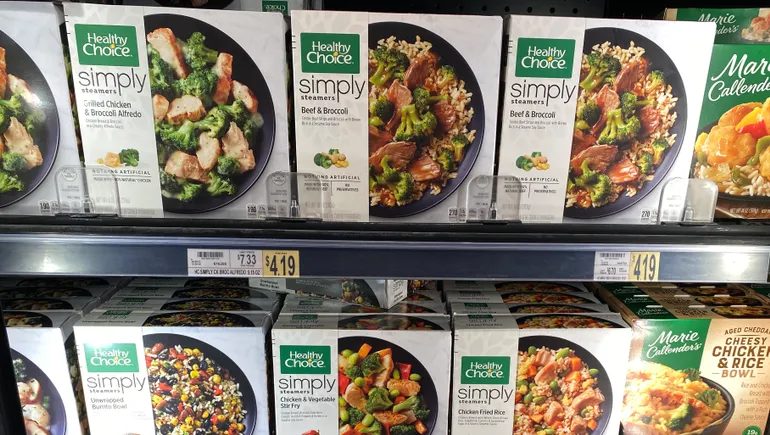Innovation driving early recovery in food volumes, Conagra Brands CEO says

The food space is seeing evidence that product volumes are starting to recover, with innovation playing a key role in helping attract more consumers back to frozen, snacks and other offerings, Conagra Brands CEO Sean Connolly said.
While shoppers continue to struggle with inflation that has forced many to cut back on purchases or alter their buying habits in other ways, Connolly said there are “some green shoots” and evidence that “more typical consumer behaviors” are starting to return.
“We’re starting to see volume trends improve,” he told Food Dive at the annual Consumer Analyst Group of New York conference in Florida. “We’re moving through some of the anxiety of 2023 back toward a more normalized place.”
Still, a meaningful rebound in consumer buying habits is several months away.
Conagra, which makes Marie Callender’s frozen meals, Snack Pack puddings and Slim Jim meat snacks, is forecasting volume momentum to build throughout 2024. It recently forecast organic sales to be down 1% to 2% for the year ending in late May.
Other packaged-food companies, including General Mills, Hershey, PepsiCo and Kraft Heinz, are among those in the sector to post a drop in volumes during their most recent quarter as inflation-weary consumers cut back on purchasing everything from chocolates and chips to cold cuts and sauces. In many cases, revenue continued to rise, albeit at a slower pace than before, as price increases offset a drop in purchases.
This has prompted Conagra and other food companies to pay closer attention to focus on what drives consumer engagement, and “the answer to that, in a word, is innovation,” Connolly noted.
Retailers also are putting pressure on food makers to accelerate innovation as they look to boost store traffic and tweak their product mix to better reflect changing consumer tastes.
Innovation largely slowed down in the food space during COVID-19 as companies focused on producing their highest-volume items.
“[Retailers] want to grow … and they understand that category growth tends to be directly correlated with innovation, and so that’s been our primary focus,” said Connolly took over as Conagra’s CEO in 2015.
During the last five years, Conagra added $1.6 billion in revenue from new products it has launched. Innovation has been the key contributor to the double-digit earnings per share growth the frozen food and snacks maker has experienced since 2016.
To generate sales, the Chicago-based food maker has overhauled once-sleepy frozen brands such as Banquet, Marie Callender’s and Healthy Choice. The firm has debuted or announced the launch of trendy products that are high in protein or gluten-free, contain premium ingredient combinations, and incorporate new packaging formats, such as bowls.
Conagra, for example, has a Lemon Herb and Chicken offering on the market, with 20 grams of protein, under its Marie Callender’s banner; and a Balsamic Garlic Steak in Healthy Choice with meat, green beans and mashed potatoes that starts shipping in May. Banquet also has added Mega Bowls and Mega Crustless Pizzas loaded with 25 grams of protein to its lineup.
The food products manufacturer has identified opportunities to bring its existing brands into new categories.
Last August, Conagra’s Orville Redenbacher line entered popcorn seasoning, a fast-growing space that has posted an 18% compound annual growth rate during the last four years, according to company data. And Chef Boyardee, best known for its pasta in cans and microwavable containers, will be entering frozen for the first time in May with spaghetti and meatballs.
Conagra, which has seen costs surge 30% during the last three years, has largely stopped raising prices on its products. The recent exception is in its tomato-based offerings, where Conagra has increased prices to offset inflation in the commodity. Instead, it’s looking to find savings internally by improving fill rates, reducing days of outstanding inventory and leveraging technology to improve its supply chain.
“We haven’t really been compelled to take additional pricing beyond that,” Connolly added, noting the temporary slowing in the pace of price inflation. “But we also equally have not experienced deflation that would suggest prices should roll backwards.”
Conagra, however, is spending more on promotional deals and store displays that dropped off industry-wide during COVID-19 and the recent upheaval in the supply chain. The packaged-food company tested some merchandising in the second quarter as consumers pulled back in certain categories to stretch their cash. Pleased with the early results, Conagra plans to ramp up its investment this year.
“We want to nudge the consumer along to get back to their typical purchase patterns,” Connolly said.
At least one analyst expressed skepticism.
Robert Moskow, an analyst at TD Cowen, said in a February research note that Conagra’s high exposure to low-income consumers will make it difficult for the business to get back to low, single-digit revenue growth. He noted Conagra was able to stabilize volumes in January through “extensive promotional discounting across more categories.”
Source: fooddive.com

